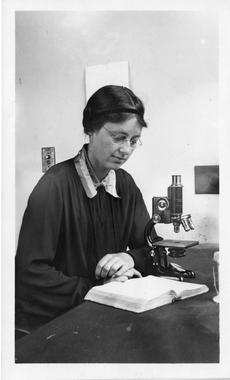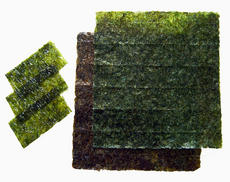Throughout March, we will be celebrating Women's History Month with new photos to the Flickr Commons and a series of blog posts about women in science from the Archives' collections.
 Every culture's cuisine has a tasty bite to whet the appetite. There is Chinese dim sum, Spanish tapas, Caribbean macarons créoles, Thai satay, and of course Japanese sushi. And it is the last one, and its link to a reserved and very private English marine botanist, that prompted this blog.
Every culture's cuisine has a tasty bite to whet the appetite. There is Chinese dim sum, Spanish tapas, Caribbean macarons créoles, Thai satay, and of course Japanese sushi. And it is the last one, and its link to a reserved and very private English marine botanist, that prompted this blog.
If you've ever eaten Japanese sushi, you are familiar with the dark green wrapper surrounding the rice-based filling. That papery bit is nori, made using a particular genus of algae, Porphyra. This reddish-purple algae, is found clinging to rocks in intertidal areas worldwide, and largely ignored. That is, except for Japan, China and South Korea, where its cultivation is a 1.4 billion dollar industry that grew out of the pioneering work of Kathleen Mary Drew Baker (1901-1957).
Although nori had been exploited for food since as early as 533 AD in China and Japan from about 1000 AD, harvests were erratic and subject to whims of nature. That is, until a Kathleen M. Drew (this is the name under which she published), teased out the complex life histories of these algae and made discoveries that later allowed the nori industry to develop and thrive.
 Goran Michanek's excellent biographical sketch on Drew points out that, in 1949, she published a very brief note in the journal Nature titled, Concheolis-phase in the life history of Porphyra umbilicalis (L) [166:7 48-9]. In the note (approx. 100 words) , "she described how the spores of Porphyra umbillicalis if brought into contact with old shells will penetrate these and develop into characteristic growth identical with an algae known as Conchocelis rosea." This discovery about one stage in the life history of this species of Porphyra gave critical insight in to how to control conditions to efficiently cultivate and harvest nori.
Goran Michanek's excellent biographical sketch on Drew points out that, in 1949, she published a very brief note in the journal Nature titled, Concheolis-phase in the life history of Porphyra umbilicalis (L) [166:7 48-9]. In the note (approx. 100 words) , "she described how the spores of Porphyra umbillicalis if brought into contact with old shells will penetrate these and develop into characteristic growth identical with an algae known as Conchocelis rosea." This discovery about one stage in the life history of this species of Porphyra gave critical insight in to how to control conditions to efficiently cultivate and harvest nori.
So indebted is the nori industry to Drew, they have honored her with a memorial park in Uzuchi Sumiyoshi-hill of the Kumamoto Prefecture, Japan. And, every April there is a memorial ceremony where nori fishermen honor their, "Mother of the Sea." Drew's contribution to the success of the nori industry, however, is not her only legacy.
During Drew's brief professional career (only 33 years), she collected 2,949 herbarium specimens (later donated to the British Museum); authored numerous papers and monographs (including posthumous) – 24 of which were published in the last four years of her life; and, was a founding member and first chairman of the British Phycological Society.
Sadly, aside from her professional and practical achievements, we know very little about Kathleen M. Drew the woman. In the final years of her life, she burned all her personal and professional papers. Only a few family photograph albums escaped.
Perhaps through archives that do survive – her letters to colleagues, family and friends; records from her school and university days; and recollections that may appear in oral histories - we may come to know her better.
Related Resources
- Kathleen M. Drew Baker (1901-1957) by Goran Michanek. "Prominent Phycologists of the 20th Century." Garbary, David J. and Michael J, Wynne, eds. Lancet Pres Ltd. (Nova Scotia) 1996.
- Kathleen M. Drew D.Sc. (Mrs. H. Wright Baker) 1901-1957. British Phycological Bulletin, 1:6, iv-12 - Collected tributes following her death
Related Collections
- Accession 90-105 - Science Service, Records, 1920s-1970s, Smithsonian Institution Archives.
Produced by the Smithsonian Institution Archives. For copyright questions, please see the Terms of Use.


Leave a Comment